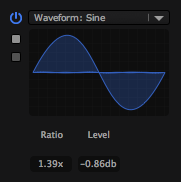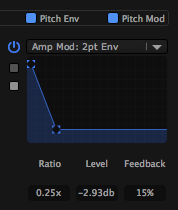DrumSpillage 1.2 introduced 2 new models based around FM synthesis. Part 1 of this article explores some of the features available in the FM Percussion model and offers a basic introduction to FM synthesis and why it is useful for creating synthetic drum sounds.

All audio clips in this article were created using DrumSpillage.
Introduction to FM Synthesis
When I recently mentioned that I was writing a blog article about FM synthesis to a friend I received the following inspirational quote:
“FM is always a complete b*tch to explain!”
Whilst there is certainly some truth to this statement the essence of FM synthesis is quite straight forward. The concept is similar to using the pitch modulation wheel on a keyboard synth or when a guitarist bends the pitch of a string up and down by waggling their fingers on the fretboard. The crucial difference is the speed of modulation. FM synthesis is essentially very fast vibrato.
Carriers and Modulators
In FM you typically use two oscillators. The first oscillator is a carrier; the second oscillator is a modulator. The modulator’s output is routed into the pitch input of the carrier; the modulator ‘modulates’ the carrier’s pitch. This has the effect of varying the carrier’s pitch up and down very quickly which in turn adds new harmonic content to the carrier signal. That’s the basic idea. Simple!
[audio:https://www.audiospillage.com/blog/wp-content/uploads/audio/fm/BasicFMTones.mp3|titles=Basic FM tones|animation=no|loop=no|initialvolume=90]The new harmonics present in the carrier directly relate to the frequencies of the two oscillators and the output level of the modulator. By varying the output level (or volume) of the modulator over time we can create interesting timbral changes to a sound.
[audio:https://www.audiospillage.com/blog/wp-content/uploads/audio/fm/ModulatedFMTones.mp3|titles=Varying a modulator’s output level|animation=no|loop=no|initialvolume=90]FM For Drums and Percussion
How can we apply FM to the realm of drum synthesis? Real drums are struck by either a stick/beater or by the player’s hands. When hit the drum emits a short burst of harmonically rich sound that quickly dies down to something that sounds more like a sine wave (or multiple sine waves).
In DrumSpillage we can simulate this and synthesize a wide range of electronic bass drums by using an envelope to contour the FM modulator:
[audio:https://www.audiospillage.com/blog/wp-content/uploads/audio/fm/FMBassDrums.mp3|titles=FM bass drum examples|animation=no|loop=no|initialvolume=90]FM synthesis also shines when you want to synthesise metallic or other noisy sounds making FM synthesis an effective source of cymbals, hi-hats, noise bursts, synthetic snares and bell sounds.
[audio:https://www.audiospillage.com/blog/wp-content/uploads/audio/fm/HiHatNoise.mp3|titles=FM hi-hats and noise example|animation=no|loop=no|initialvolume=100]The FM Percussion Model in DrumSpillage
 The FMPercussion model offers a total of three oscillators and five algorithms. The algorithms define the configuration of inter-connections between the three oscillators and consequently has a huge impact on the final sound. For example, in algorithm 1 (right) oscillator 3 is a modulator but oscillators 1 and 2 are both carriers, frequency modulated by oscillator 3.
The FMPercussion model offers a total of three oscillators and five algorithms. The algorithms define the configuration of inter-connections between the three oscillators and consequently has a huge impact on the final sound. For example, in algorithm 1 (right) oscillator 3 is a modulator but oscillators 1 and 2 are both carriers, frequency modulated by oscillator 3.
In all 5 algorithms wherever you see one oscillator above another (and the two are connected) the lower oscillator is the carrier and the upper oscillator is the modulator. More about algorithms in part 2.

Each oscillator has a standard set of controls (right) allowing you to change its pitch, basic waveform (sine, triangle or square wave) and output level.
The Ratio control sets the oscillator’s pitch (relative to the master pitch slider) and the Level control controls the output level (volume) of the oscillator. If an oscillator’s output is routed into another oscillator (i.e it is a modulator) then the level control can be used to vary the richness of the final sound. Higher modulator output level = increased harmonic content in the carrier.
Effective Use of Modulators
Varying the level of a modulator oscillator during frequency modulation is the key to creating interesting and unique FM sounds. In DrumSpillage this technique is called amplitude modulation or ‘amp mod’ for short. Amplitude in this context is basically just another name for volume or output level.
The FM Percussion model in DrumSpillage gives you a number of ‘amp mod’ sources for each oscillator:
- Amp mod off (static volume)
- 2-point envelope
- Env 1 and Env 2
- LFO 1 , LFO 2, LFO 3 and LFO 4
Only one of these sources can be selected at a time. To access the amp mod sources click the lower of the two square buttons to the left of the oscillator view.

When the Amp Mod: parameter is set to ‘Off’ the oscillator’s level remains constant. The 2-point envelope setting (right) allows you to set a start and end point for the oscillator’s level and also the time it will take to move between these two point. Simply drag the small square handles to set the envelope shape.
When Amp Mod: is set to Env1 or Env2 the oscillator’s level will follow the shape of either Envelope 1 or Envelope 2 (the built in ADSR envelopes). You can also use one of the built in LFOs to modulate the oscillator’s level (e.g. LFO1, LFO2, LFO3, LFO4). To change the depth of the envelope or LFO modulation effect click and drag inside the oscillator’s graphic view.
Finishing Touches
Each oscillator can be turned on and off using the small power switch in the top left corner above the graphic display. You can also turn the pitch envelope and pitch modulation on and off on a per-oscillator level using the switches above the oscillator view. Oscillator 3 is unique in that it features a feedback control (currently only available when waveform is set to ‘sine’) which will be covered in more depth in the second installment of this article.
In part 2 we will provide more examples of the FMPercussion model in use and in the process build an entire kit using just the FMPercussion model.
Thanks for reading and see you in part 2!
